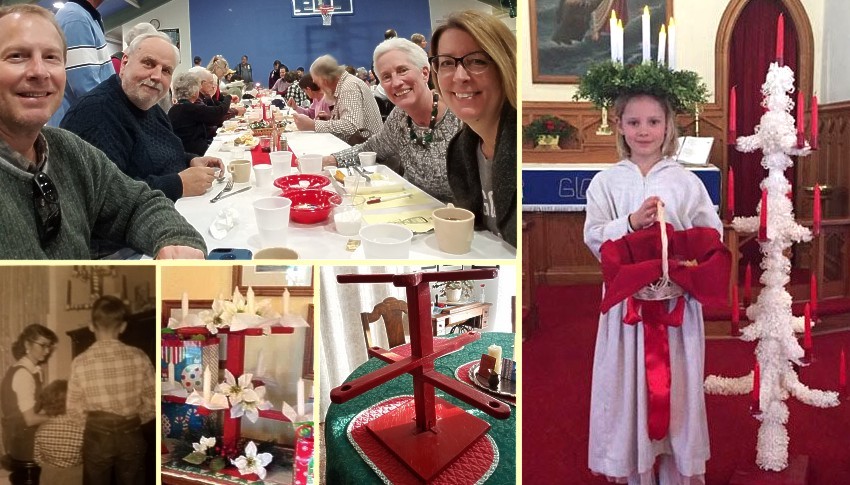Kansas Snapshots by Gloria Freeland - December 13, 2019
Swedish season of light
Being a land of immigrants, it's no surprise that our Christmas celebrations feature traditions from other countries. For example,
the ubiquitous evergreen tree can be traced to Germany. But for me, this time of year always seems to make me pause and think of my
Swedish heritage. This may be prompted in part by my making arrangements for and attending the annual Swedish dinner in nearby
Olsburg.
Mom's and Aunt Edith's mother Hulda was born in Iowa of Swedish-immigrant parents who came in the late 1800s. Grandpa Nels arrived
in 1909. He met Grandma in Colorado and they settled on a farm in Morris County, Kansas, not far from where I grew up. But it was
far enough that we didn't participate in their Swedish Lutheran Christmas services or partake of the typical food, including
lutfisk, potato sausage, Swedish meatballs, pickled herring, ginger snaps and others.
Grandma died when I was 7, and at that age, I didn�t really think much about my heritage. But as I got older, I listened
intently as Mom and Edith reminisced about their Swedish traditions from when they were growing up near the Marion Hill Lutheran
Church.
Mom didn't prepare any typical Swedish Christmas foods during the holidays, but the small gold metal angel set we had is still part
of my holiday decorations. When the narrow tapers were lit, the heat from the flames caused the air to rise and make the angels
spin and gently strike the nearby bells.
Another Swedish tradition involving candles and fire is connected with the shortest day of the year in the northern hemisphere
being in December. Pagans traditionally held celebrations involving fires at this time of year to banish the dark and in anticipation of the
days getting longer. The Christian church sort of co-opted many pagan rites to bring people into the religion. In many European
countries, this December festival of lights became St. Lucia's (Lucy's) Day.
According to church lore, St. Lucia was a young Christian girl, who was martyred in 304. The most common story about her is that
she took food to persecuted Christians in Rome, who lived in the catacombs under the city. She wore candles on her head so she
could see in the darkness and her hands were free to carry the food. The name Lucy comes from the Latin word "lux" or light.
Just as Santa is an old man with a red suit and a black belt, Lucia has an expected "look" as well. She is always represented by
a young woman in a white dress - a symbol of a Christian baptismal robe - and red sash - symbolizing the blood of her martyrdom.
She wears a crown or wreath of candles on her head. The crown is traditionally made of lingonberry branches, which are evergreen
and represent new life in winter. As songs are sung, girls dressed as St. Lucia carry cookies and saffron buns in procession, a
sign of bringing Christianity's light to a dark world. The tradition is celebrated in all Scandinavian countries, Bosnia, Croatia
and American cities that have large Scandinavian populations.
The joining of the Swedish words for light - ljus - and crown - krona - creates the Swedish equivalent to the English word
chandelier. But ljuskrona (yoos-krona) is also used for a bare-bones candle holder that recalls St. Lucia's crown. It is a stylized crown frequently
made from discarded materials and wrapped with cut newspaper, wrapping paper or crepe paper. Traditionally, they are set out on
Dec. 13.
Grandpa made a crude wooden ljuskrona he painted bright red. Edith kept it after his death, but after she died in 2016, her
daughter Linda and husband were in the process of downsizing and didn�t feel they had a place for it in their new home. That is
how I became the keeper of this heirloom.
At the time, I wasn't sure whether I wanted to keep it. It's too large to be a table centerpiece, and too small to stand on the
floor. It's simply made - not a sleek thing of beauty by any standards. But I had seen pictures of it decked out with poinsettias,
greenery and candles resting on lace doilies, so I couldn't just let this part of my family history go.
It was with thoughts of what I was going to do with Grandpa's ljuskrona that husband Art and I started for Olsburg last Saturday.
It would be the community's 63rd Swedish supper and our 15th. Our first time was in 2005 when we took my mother, her friend Stan,
and our German exchange student Nadja to enjoy "Kaffe och lutfisk." My
"Swedish food and Swedish memories" column from 2014 was prompted by Edith joining us. This
year, we went with friends Dave and Susan, as we have the last five years. Art proclaimed it as the best so far, partly because of his ever-increasing penchant for the lutfisk - a pronouncement that makes
me ponder his mental health status.
But once home, I again began to think about Grandpa's ljuskrona. Yes, it is crude and even he would probably laugh over the fuss I
am making over it. But just looking at it and thinking of him and his always-positive outlook on life ... well, as intended, in
this Swedish season of light, it just seems to bring light to my season!
